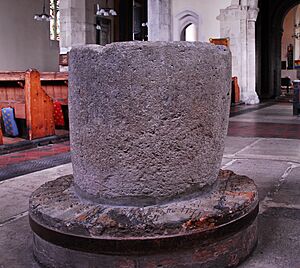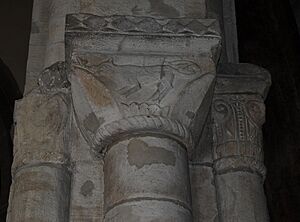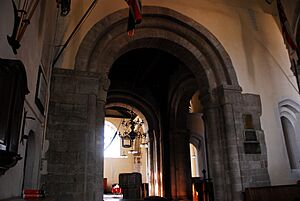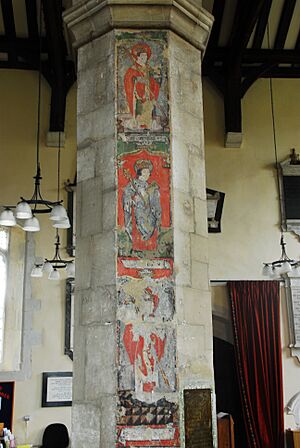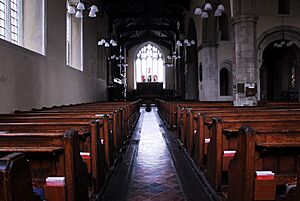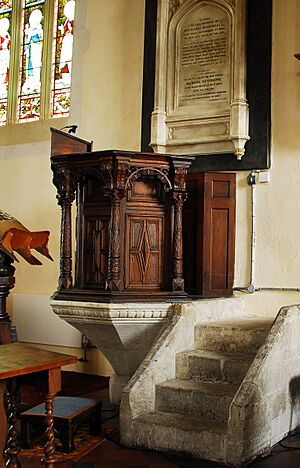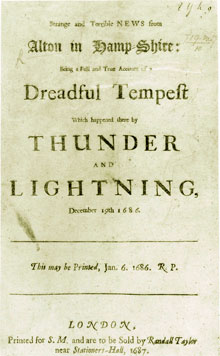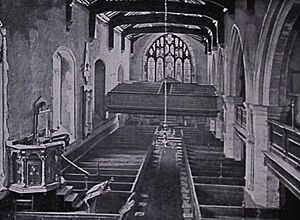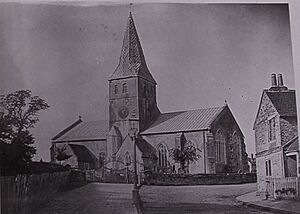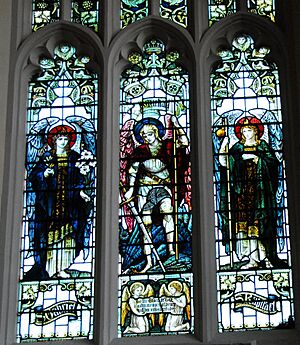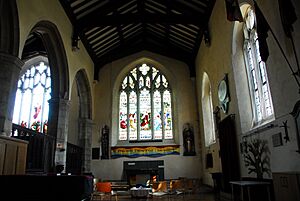Church of St Lawrence, Alton facts for kids
Quick facts for kids Church of St Lawrence, Alton |
|
|---|---|
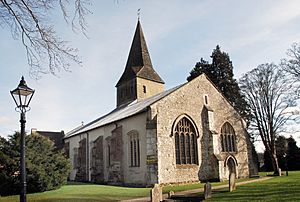
Church of St Lawrence from the north-west
|
|
| 51°09′04″N 0°58′34″W / 51.15118°N 0.97624°W | |
| Location | Alton, Hampshire |
| Country | England |
| Denomination | Anglican |
| History | |
| Status | Parish church |
| Founded | c. 1070 |
| Dedication | St Lawrence the Martyr |
| Architecture | |
| Functional status | Active |
| Heritage designation | Listed building – Grade I |
| Designated | 12 April 2005 |
| Architectural type | Church |
| Style | Norman, Early English, Perpendicular |
| Specifications | |
| Materials | Stone |
| Administration | |
| Parish | Parish of the Resurrection |
| Diocese | Winchester |
| Province | Canterbury |
The Church of St Lawrence, Alton is an Anglican parish church in Alton, Hampshire, England. It is a very old and important building. It is famous for its different styles of architecture. It is also known for being the place where the final part of the Battle of Alton happened during the English Civil War. The church is a Grade I listed building, which means it is a very special historic place.
Contents
Church History and Design
The Church of St Lawrence, like many old churches in England, has been built and changed over many centuries. This means it shows different building styles from different times. You can see early Norman, Early English, and Perpendicular Gothic styles.
Early Beginnings: Anglo-Saxon Times
People settled in Alton around the year 500 AD. There was probably a church here even then. We don't have any parts of that first church. But we do have a baptismal font from that time. It is made from a huge stone block. You can still see rough axe marks on it.
In 1868, during a big church renovation, this old font was put aside. It ended up in Cirencester. But in 1934, it was bought back for £10. Now it stands in the church on a mill wheel. This wheel reminds us that Alton was a center for making paper. The font has been used again for baptisms since 1950.
Norman Church Building
The church we see today started in the Norman period. Building likely began soon after 1066. The church celebrated its 900th anniversary in 1970, so it was probably founded around 1070.
The first Norman church was shaped like a cross. Four Norman arches formed the tower. These arches are from around 1100. They were built with stone from nearby places. You can still see parts of the original door behind a newer font. The tops of the pillars supporting the arches have carvings. These were made by French artists. They show a wolf eating a bone, a pelican, angels, a demon, and donkeys.
This Norman church became the property of William the Conqueror. He got it from Edith of Wessex, the wife of Edward the Confessor. This happened after the Norman Conquest. In 1087, William traded the church with monks from Hyde Abbey in Winchester. He wanted their burial ground to build his new palace.
Alton grew richer in the 1100s. It was on the main road to London. So, the church needed to be bigger. The southern part of the church was extended to the west. Work was also done on the north side. The old west door was built in 1140. It was later walled up in 1868. The first known vicar of Alton was Richard Turstin. He was a parson from 1161 to 1170.
Changes from the 13th to 15th Centuries
Even with the changes in the 1100s, the church was still too small by the 1200s. So, the Lady Chapel was added to the east of the Norman tower. This chapel had special spots in the wall for statues. They used to hold statues of St Lawrence and the Virgin and Child. Today, they hold wooden statues of St George and St Michael.
The famous Alton Fair began in 1307. For a while, the church grounds were used for markets and parties. But in 1317, the Bishop of Winchester stopped this. He said fairs could not be held in churches or churchyards. This is the first time we know that St Lawrence was the church's patron saint.
The 1400s brought many more changes to St Lawrence's. A new northern part of the church was built. It was about the same size as the southern part. The old north wall was taken down. Seven arches were put in its place. Three paintings of saints can still be seen on one of the pillars. New roofs were added to both parts of the church. Windows were changed to the Perpendicular style. Carved screens were added for the choir and altar. A spire was put on top of the old tower.
The outside of the church, except for the Victorian spire, also dates from the 1400s. It is made from local flint and stone, covered with plaster. A chapel was built in the southern part of the church. This is now the choir vestry. Another chapel, called the Champflour Chantry Chapel, was built to the north of the choir. Only a stone piece of it remains today.
16th and 17th Century Developments
After the Dissolution of the Monasteries, the Church of St Lawrence came under the care of the Dean and Chapter of Winchester in 1541. It seems the church was also a place of learning back then. A report from 1548 mentions a priest in Alton who taught children grammar.
More building work happened in the 1500s. The south door and porch were added. A special entrance for the priest was made for the Lady Chapel. The church's history becomes clearer in the 1600s. Parish registers started in 1615, and church records began in 1625. These records continue to this day, with only small gaps during the English Civil War.
The church records from 1625 mention that the church had a set of bells. These bells were rung when King Charles I visited the town in 1625. The church's pulpit, which is very old and special, also dates from this time.
The Battle of Alton
The Church of St Lawrence played a big part in the Battle of Alton. This battle was part of the English Civil War. It happened on December 13, 1643. Alton was a town that supported the King (Royalists). On December 1, 1643, a large Royalist force came to Alton.
Parliamentary forces, led by Sir William Waller, marched to Alton on December 13. The Royalist leader, the Earl of Crawford, left Alton for Winchester. He left behind a smaller force led by Colonel Richard Boles. This group was pushed back through the churchyard of St Lawrence's. They eventually hid inside the church. They built platforms to shoot from the windows.
The Royalist soldiers fought bravely. They saw the church as their only chance to survive. They pulled back towards the open doorway, still fighting. The Parliamentarians attacked hard. They threw hand grenades into the church windows. Finally, they broke through the west door. Colonel Boles, who had told his soldiers not to surrender, was killed. People say he died on the steps of the pulpit.
You can still see bullet holes in the church's south door. There are also marks on the walls and pillars inside. When the church was repaired in the 1860s, many bullets were found in the ceiling. Soldiers who died in the battle were also found buried in the churchyard. Some items from the battle, like a key, a uniform button, bullets, and a pipe, are shown in a display cabinet in the church.
A brass memorial to Colonel Boles is on one of the pillars. It says:
Alton will tell you of that famous Fight
Which y man made & bade this world good night
His verteous Life fear'd not Mortalyty
His Body must, his Vertues cannot Die
Because his Bloud was there so nobly spent
This is his Tombe that Church his Monument.
When King Charles I heard about Boles's death, he said, "Bring me my mourning scarf; I have lost one of my best commanders in this Kingdom."
1686 Thunderstorm Damage
On December 19, 1686, a powerful thunderstorm hit Alton. It caused a lot of damage to the church. An eyewitness said that it suddenly became very dark during a church service. Then, bright flashes of lightning made the whole church look like it was on fire. Two "Balls of Fire" entered the church. They left behind a lot of smoke and the smell of sulfur.
All the church windows were broken. The roof and steeple were badly damaged after catching fire. The tower had a hole blasted through it. The weathercock was carried away. No one was hurt, but the vicar's eyebrows were singed. Church records from 1687 show many repairs were made. The church bells still rang in 1687 for King James II and in 1688 for William III and Mary II.
18th Century Changes
During the 1700s, many galleries were built inside the church. By the time Queen Victoria became queen, the church was full of them. There was a singing gallery at the west end. Some galleries were for people who paid, and some were free.
In 1724, work began to change the church roof from tiles to lead. This was finished in 1758. Before this, the church had a three-part roof. After the work, it became a single-span roof, which it still has today. In 1742, a plain window was replaced with a square glass window to let in more light.
The church also did a lot of charity work. In 1741, John Fisher gave £8 every year. This money was for three sermons in Alton Church and for giving bread and money to the poor. The Poor House was set up in 1740. The church was also in charge of keeping the town's fire engine.
John Murray, who started the Universalist religion in the United States, was born in Alton in 1741. He was baptized in St Lawrence's.
19th Century Renovations
Three more galleries were built in 1810 and 1824. In 1817, Francis Austen, the brother of writer Jane Austen, helped manage the church's affairs. In 1829, the church bought a "barrel organ."
Major Restoration Work
In 1862, a big effort began to restore the church. The church needed more space for the growing population of Alton. The old galleries were removed. A new north aisle and a western gallery were added. The church was re-seated to fit more people. This work cost about £2,500.
The renovations were finished on April 16, 1868. The Bishop of Winchester reopened the church. Many new things were given to the church. These included a new font, a lectern, new windows, and new seating. The most important addition was a pipe organ. It cost £850 and was paid for by public donations. This organ was used until it was rebuilt in 1966.
A permanent choir was also started. Other changes included adding a window to the tower and a staircase to the bell tower. The old west door was filled in with stone. New pews were installed. The church could now seat 816 people. To serve Alton's larger population, a new church (All Saints' Church) was built, and the parish was divided.
Tower, Steeple, and Clocks
In 1874, the steeple was covered with oak instead of lead. A weather vane was placed on top. This is the steeple we see today. The church tower has had clocks for a long time, at least since the 1600s. The clock used today was put in place in 1890.
Sundials have also been used at the church for many years. One on the east side of the church might be from the 1300s or earlier. The one in the churchyard today is from the 1700s.
Beautiful Stained Glass
All the stained glass windows in the church are from the Victorian period. The east window (1870) was made by Jean-Baptiste Capronnier. The Mary window (1873) is dedicated to Martha Hutchins. The window in the Lady Chapel (1884) was also made by Messrs Heaton, Butler and Bayne. The window north of the main altar (1899) shows the archangels Gabriel, Michael, and Raphael. It was dedicated to Henry Hall. When Hall's wife died, a mosaic showing Faith and Charity was added around the archangel window in 1906.
20th Century Updates
Chapel of St Michael and St George
The Lady Chapel was turned into a war memorial after World War I ended in 1918. During the war, the vicar kept a list of soldiers who died. After the war, this list was put on a wall tablet. It says: "To the glory of God/In memory of the men of this town/Who gave their lives in the Great War 1914–18/And in thankfulness for many who have been spared/This chapel is restored A.D. 1919."
The chapel was officially opened by the Bishop of Winchester on November 28, 1920. In 1927, statues of St Michael and St George were given to the church. These statues are in the niches where St Lawrence and the Virgin and Child statues used to be. Other additions to the chapel include new tablets, movable oak pews, and a grand piano.
More Changes and Improvements
In 1920, money was raised for more work on the church. The main work was done on the tower and the roof. The western gallery, added in 1868, was taken down. A new set of eight bells was made for the church in 1926. The old wooden bell frame was replaced with a steel one.
In 1932, it was found that the tower was cracking. This was partly because of the bells' vibrations. So, the bell cage was made stronger with steel. The walls around it were also strengthened with reinforced concrete. In 1939, the church changed from gas to electric lighting. This was done in memory of Dr E. J. L. Leslie.
More work was done on the organ in 1993. The parish center, St Lawrence Hall, was built about 100 meters south of the church in 1970.
Vicars of St Lawrence
- John Neuport, active around 1399
- John Shavyngton, active around 1501
- William Tyndall, active around 1630
Images for kids



